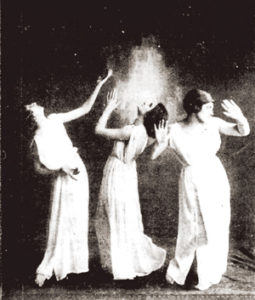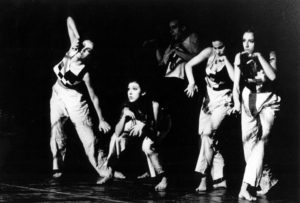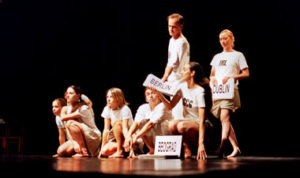PDF available here.
Ana Vujanović (2007-2011)
In order to write about the current situation of contemporary dance in Serbia, I could begin with the conceptualization and contextualization of its synchronic relations with the neighboring scenes, then also with other European or Western ones. As contemporary dance is a new phenomenon in Serbia, there are two problematic theses that I would like to put forward as starting points. Firstly, as there is no local contemporary dance history, there is no need to follow the diachronic traces of the present situation; and secondly, what is currently considered and practiced as contemporary dance in Serbia is contemporary Western dance. Hence, my task here is to clarify the influences, uses, transfers, translations, and appropriations of Western dance paradigms to this context that is not-quite-Western but not-right-Eastern either. Thus my starting point is plain and clear, though harsh. And yet, is it sufficient? I wouldn’t think so. But then, what can we do?
I will now try to examine my theses, in the hope that some new problems might eventually emerge. I will adopt a theoretical-political approach, maintaining that making problems forces us to rethink our common beliefs and habits. Consequently, this essay does not entertain a positivist-scientific approach.[1]
A Historio-political Lesson on the Past and the Present of Local Contemporary Dance
The “Prehistory” of Local Contemporary Dance
It is not quite true that there is no local history of contemporary dance. However, what we can identify as the local dance history is a fringe non-teleological network of past traces of various “body movement practices” in art and culture. It does not lead to the current contemporary dance in Serbia; and it differs from the official dance history, i.e. the dance history of Western Europe and the USA. It is rather an archeology of more or less isolated or loosely connected points, lost tracks, ruptures, parallel flows, accidents, breaches – a genealogy of the discontinuity of beginnings…
Before World War II, in the Kingdom of Yugoslavia there were two established paradigms of body movement as cultural-artistic practice in Serbia. One is the work of philosopher and choreographer Maga Magazinović, whose vision of body emancipation was realized through a “new dance” combination of gymnastics, plastics, rhythmics, feminism, and physical culture as education.
She combined the dance techniques and poetics of Emil-Jacque Dalcroze and Rudolf von Laban, Isadora Duncan and Marry Wigman, blended with Rudolf Steiner’s anthroposophy. In conjunction with this, I must mention the avant-garde dance of Klavdija Isačenko, who, apart from working in the National Theater in Belgrade after she left post-revolutionary Russia, introduced ‘body plastics’ and made choreographies in Ljubljana (Plastic Ballet) and Belgrade (The Sobareva metla [Janitor’s Broom]). Her work opens a new chapter in the past of local dance but, unfortunately, after only five years Isačenko left Serbia, and being completely erased from history, she did not exert any influence. The other paradigm at the time was the work of the Sokoli (Falcons) movement, who appreciated the human body in terms of building a healthy collective body for the pan-Slavic nation. Although they made us of similar notions – health, emancipation of the body, physical culture – the ideologies of these two paradigms differed: emancipation of the individual vs. training of the collective. Consequently, while Magazinović conceived dance as art pieces for small numbers of (female) performers, Sokoli organized slets, a form of cultural-sport performance for numerous performers of various types.
After World War Two, both paradigms had their impact on the body art and culture in Serbia, and the whole Socialist Federal Republic of Yugoslavia. Magazinović had her own studio and school in Belgrade, and her student Smiljana Mandukić continued working within her own group, later known as the Belgrade Contemporary Ballet; then a few different trends developed, from amateur dance within cultural-artistic societies (e.g. Dubravka Maletić) to the physical theater in the 1990s. On the other hand, Sokoli’s slet grew into an officially promoted form of body movement presentation – as was the case in many communist countries – in various state parades and festivals, the biggest among them being the Dan mladosti slet (Youth Day Rally, also President Tito’s birthday) on May 25th. If these dance paradigms ever had critical social potential, they mostly lost it in their ideological mutations of the 1950s and 1960s, when they became the ideal projection of the “socialist body,” never seen in terms of atomized individuality, but of particularity invested into the collective.
What we need to keep in mind about the history of dance in Serbia were the body practices developed within the new art forms: the performance art, body art, and happenings of the 1960s and 1970s. In these examples, we cannot speak of dance in its current sense, as it was rather dance “piercing through” other disciplines of art – contemporary visual arts and neo-avant-garde theater.[2] However, we should seriously rethink the status of the artist’s (and especially the female artist’s) body in the works of, say, Marina Abramović and Katalin Ladik, which were completely ignored by the dance theory and criticism of the time. Several decades later, their conceptual legacy is clearly visible in contemporary dance, and more conspicuous than any derived from ballet, or amateur, folk, or popular dance, which were exclusively perceived as dance at the time. Their main contribution was in conceiving the body along two vectors: as artistic material or as a tool (i.e. as the object or medium) and as that of an artist (i.e. as the subject of art).
We encounter various forms of contemporary dance in the postmodern theater of the late 1970s and 1980s – admittedly, more advanced in Slovenia and Croatia than in Serbia. Here, dance was one of the media of post-modern theater in its broadest sense. In this context, I should mention the theater directors Nada Kokotović, Ljubiša Ristić, and Haris Pašović, as well as choreographer Sonja Vukićević. “Choreo-drama” and “small-stage dance” as distinct dance forms developed in this context, advocating the liberation of the ballet body through a less codified body movement, exploring extensive theater references through narration and stage design. Although Kokotović’s large-scale choreo-drama performances are the most prominent dance of this period, in this outline I would draw attention to Sonja Vukićević, who was a symptomatic dance figure for the local paradigm shift from the collectivism characteristic of socialist countries (the SFRY), toward the individualism characteristic of capitalist countries (the new states, after the disintegration of the SFRY). In fact, she starred in the last Youth Day slet, performed in 1988. And, instead of the ordinary slet, what took place that year was a modern dance performance based on fragments of Damir Zlatar Fray’s Bolero, where Vukićević performed as a solo dancer, though together with 9,000 young people.[3] For the first time one could see an individual, clearly singled out from the anonymous mass of dancing bodies, promoted officially before “the eyes of the nation” – signifying the collapse of the “come together!” slet ideology, which hailed the quite material collapse of Yugoslavia as a socialist state.
Contemporary Dance in Serbia; The Lack of a Dance Institution/Discipline
In discussing the situation in the 1990s and early 2000s we can finally speak of contemporary dance in the current sense of the word, in spite of the fact that it was not recognized as a separate artistic discipline at the time.[4] It emerged and evolved during the 1990s within the alternative theater scene in the Federal Republic of Yugoslavia – mainly in Belgrade and Novi Sad – as nonverbal, physical, dance theater, and theater of movement, and in various other forms of experimental theater and performance. In fact, alternative theater artists practiced various hybrid forms, taking theater and intersected it with modern and postmodern dance. Important contributors to this scene were the following independent theater groups and artists: Signum, Dah teatar, Ister teatar, Plavo pozorište, Mimart, Vukićević’s initiative within the Center for Cultural Decontamination, Omen, Erg Status, Ogledalo, Ivana Vujić…; and alternative theater festivals, such as BELEF, BITEF, INFANT, and FIAT (in Podgorica, Montenegro).
From the perspective of this type of institutional/discursive frame, the main influences on local dance in the 1990s came from the theater: namely, theatre anthropology, choreo-drama, Brechtian theater, Tanztheater, street theater, butoh and other Far- and Middle-Eastern forms, and not from the international (Western) dance scene of the period. For instance, before the early and mid-2000s there was not a single reference to “conceptual dance,” which was booming on the international scene in the late 1990s and early 2000s. Instead, there were plenty of references to the neo-avant-garde of the 1960s, perceived as a repository of artistic and political tools that remained relevant. The theater background of the local dance scene can also help us to understand the notable interest SOROS: Fund for an Open Society showed in supporting many of these productions. Throughout the 1990s the Fund was the main sponsor of the non-institutional cultural-artistic projects in FRY, due to their “progressive” political content. In Serbia, it was the resistance to Slobodan Milošević’s regime and promotion of neo-liberal democracy through the humanist discourse of universal freedom and human rights.[5]
This indicates that the social role of dance was meant to emerge in its political content (rendered through theatrical elements, like narration), and not in critical reflection upon the institution of dance, or upon the historical legacy of ballet or modern dance, as was the case in the West. This specific socio-artistic context of Serbia in the 1990s answers why the contemporary European dance concerns did not affect local artists – to put it simply, our histories had parted ways.
The Early Days of the Local Contemporary Dance Scene as a Contemporary Dance Scene
From the mid-2000s on, we have witnessed an emergence of a contemporary dance scene that has eventually been recognized and has established itself as THE contemporary dance scene.
Still, I have claimed that there was no such thing as a “contemporary dance scene in Serbia” in the early 2000s. In fact, there have been a few choreographers and dancers active since the beginning of 2000s, such as Bojana Mladenović, Dalija Aćin, Isidora Stanišić, Dragana Alfirević, Dušan Murić, Olivera Kovačević, Saša Asentić, etc.
However, a crucial condition for building a dance scene was missing. This condition is an organizational infrastructure, as the Artworld informs us.[6] Ultimately, there were no dance platforms in Serbia that could organize the dance scene as a wider organizational, theoretical, and artistic context for single productions, nor a social system of dance which started with education and ended with public presentation. Thus, dance pieces appeared as rare events, produced by a few of the most active choreographers, in an almost empty space. This could not count as a scene, however important they might have been.[7]
However, in spite of the scarcity of contemporary dance productions, during the second half of 2000s the situation changed on a macro-level. Since then, the contemporary dance scene in Serbia has had a certain number of subjects to call its own. Besides the above-mentioned choreographers and performers, there are two specialized organizations: Station, a dance service in Belgrade, and New Dance Forum, a project of the Serbian National Theater in Novi Sad (which collaborates with Per.Art). Furthermore, apart from the REX and CKZD cultural centers, several official theaters have opened their doors to contemporary dance programming (Bitef Theater, Belgrade Drama Theater, and the Serbian National Theater), as have some theater festivals (BELEF, BITEF, INFANT, the specialized Choreographic Miniatures, and independent small-scale festivals such as Pro Tools, organized by Walking Theory: TkH in 2004, Kondenz organized by Station from 2008 on, and Nov-ples organized by Per.Art in 2010). Influences have come directly from abroad through workshops and presentations organized by Station, TkH, and Per.Art, and through guest choreographers invited by Forum. More productive, multi-lateral collaborations have been carried out within the region of the Balkans or the former Yugoslavia through initiatives, networks and platforms: Balkan Express, Balkan Dance Platform, Nomad Dance Academy, East Dance Academy, Balkan-Can Contemporary, etc. For these various micro-artistic contexts they facilitate help in raising their profile, transferring knowledge and know-how, mutual validation, and empowerment. What has changed the most is access to public funds and international grants. For a few years in the late 2000s, dance in Serbia was regularly (though still insufficiently) supported by the Ministry of Culture, the City Councils for Culture, Pro Helvetia, the European Cultural Foundation, and foreign cultural centers. However, this mainly project-based support has not improved the infrastructure, which has presented a big problem, whose consequences emerged soon after the short-term “spring.” Unable to establish more sustainable independent structures, in part because of having lost the interest of public authorities in supporting the contemporary dance scene, at the current moment it is in decline – Forum no longer functions regularly, Station is closing down, and some of the most active actors have left the country (Dragana Alfirević, Bojana Mladenović, myself, Dragana Bulut, Marko Milić…).
What the contemporary dance scene in Serbia still lacks is a broadened dance community and theoretical/critical discourse. This broadening should be understood in terms of both the coming of a new generation of choreographers and dancers, and the decentralization of the scene. The latter overlaps with the wider problem of the extremely centralized cultural policy in Serbia, as a result of which the dance scene does not exist at present, outside of Belgrade and Novi Sad, the two largest cities. Important projects were conceived by Station to address the problem of growth, at least in terms of supporting a new generation: Fostering Creativity and the Nomad Dance Academy. They contributed to raising the profile of a certain number of new artists, among whom I shall mention Ljiljana Tasić, Dragana Bulut, Ana Dubljević, Marko Milić, and Igor Koruga. As for the second problem, theoretical/critical writing on contemporary dance in Serbia is still sporadic, and there is not a single theorist or critic specialized in contemporary dance. The crucial problem here is education, as contemporary dance is completely excluded from academia. Some independent efforts, such as the Walking Critique school edited by TkH within BITEF, which later became a self-organized group, could not manage to resolve this problem in the long term, due to financial problems and the strong resistance of the local theater circles. Hence, there is only one privately published ballet/modern dance magazine, Orhestra; a few critics, like Jelena Kajgo, Milica Zajcev, Ivana Milovanović, Milica Cerović, and Igor Burić, report on dance and ballet in Serbia for daily newspapers; linguist Svenka Savić has dealt with the semiotics of dance, and a few theorists of performing arts and culture, associated with the TkH platform and TkH Journal for Performing Arts Theory deal with the contemporary performing arts, where dance is one of the focuses. In materialist terms, the demand for discourse is rising as the scene is growing, but the right “supply” has yet to appear, because education in a new field is time-consuming, and it is still impossible for any local critic or theorist to specialize in contemporary dance and make a living on the salary of a few reviews per year.[8]
Dancing Social Bodies, or: Who Has the Right to Contemporaneity?
This has been a brief theoretical-historical overview of the past and the present of contemporary dance in Serbia from a subjective perspective. What I would like to engage in now is a more theoretical and politically-laden discussion of the current state of affairs.
When I argued at the beginning of the text that writing on contemporary dance in Serbia may start from the present, I implied not only that contemporary dance was a new phenomenon in Serbia, but also that my writing did not need to contemplate its local historical background, since what we have here and now is contemporary Western dance. At that point I left the thesis aside and attempted to clarify what we had in the past in place of contemporary dance. I would now like to resume this issue.
In 2001 Janez Janša (Emil Hrvatin) put forward a provocative statement: “Contemporary dance exists only in democratic societies and not in non-democratic ones”;[9] and he recently added: “…but only in institutional terms.”[10] His argument draws from the notion of the emancipation of the individual – through contemporary dance – as emblematic for democratic societies. This approach is a plausible explanation for why there was no modern dance in Eastern Europe after World War Two under the (semi-)totalitarian socialist regimes, as opposed to the situation in the democratic West – whose democracy was also questionable at the time, but at least implied a multi-party political system. However, what we can see from my theoretical historicization is that, although there was no Contemporary Dance, besides the Ballet Blanc at the National Theater and traditional folk dance, there were other, different kinds of dance or, basically, body movement in Serbia during socialist times. Prominent in more or less all of them was the general idea of collectivism, which shaped the predominant conceptions of the body, as well as dance forms. Hence, while keeping with Hrvatin’s notion of emancipation through dance, I would rather shift the critical focus. The crucial distinction for a social and political contextualization of contemporary dance (in history) is not between democratic and non-democratic societies, but between capitalist and socialist ones. Accordingly, “emancipation of the individual” (attributed to democratic societies) is not the reverse of ideology (imputed to non-democratic regimes), but a particular principle of the latter. And its opposite on the other, ideological side is “collectivism.” The former concept is specific to capitalist societies and basically derives from the economic principle of private property and ownership, as its supra-structural ideological foundation. The latter came from the vocabulary of communist ideology, and pertains to its landmark concept of social property and public good. In the case of SFRY, according to the principles of workers’ self-management and associated labor – Yugoslavia nominally being a multi-cultural and classless society – this ideology was condensed into the slogan “Brotherhood and Unity.” Therefore, what we encounter in capitalist societies is a history of contemporary dance as a high art practice of the emancipation of the individual – the rendering of an autonomous social subject through the liberation of the individual body, expressiveness, creativity, and innovation. On the other hand, in socialist countries such a practice would have been perceived as a bourgeois luxury. What was required was a socially and economically efficient collective; dance filled this role as a ‘come together!’ activity, along with the nearly anonymous cultural practices of slets, parades, amateur dances etc.[11]
I will abstain from the evaluation of these dance forms in terms of artistic or aesthetic value, to conclude with something that seems to me more central. From what I have said, I would infer that dance as a cultural-artistic practice (and this implies contemporary dance as well), is never practice of human emancipation disengaged from ideology, but a tool for shaping the singular body as the social body. I propose this as a basis for a social way of thinking about dance, as a critical theoretical-political platform from which we could and should start addressing the aesthetic differences and particular purposes of this tool, as well as its complicity with or resistance toward the dominant ideologies of certain social contexts.
This initial standpoint also helps explain the emergence of contemporary dance in the new post-socialist European countries; with the transformation of their economic and political structures, toward capitalism and the multi-party political system, their ideologies have changed as well.
But what is it like in “real life”? There are in fact two, seemingly opposite sides to this process, which should be understood dialectically. There is fierce criticism of contemporary dance influences that come or, rather, are being “imported” from “the West.” So often in recent years have I heard complaints by dance practitioners from Tallinn to Skopje that the only dance in the former Eastern Europe that is supported both locally and internationally is choreography markedly shaped by Western contemporary dance influences, and conceptual dance in particular. On the other hand, Eastern choreographers who work along the current lines of contemporary European dance are used to being labeled by Western programmers and critics as lacking anything specifically Eastern and, accordingly, of “always being too late” with regards to the West.[12] The unbearable ambiguity of this position is even the main concern of Saša Asentić’s dance lecture-performance My Private Bio-Politics.
Returning now to my arguments from the previous paragraphs, the question of assumed “colonization” of former Eastern Europe through contemporary dance is thrown into a different light. Namely, I would rather assume that this is less a question of colonization or an outer aggression, than of the inner transformation of Eastern societies, adopting the capitalist social structure already developed in the West after World War Two. Their transformation annihilates the distinction between the (socialist) East and (capitalist) West – although neither ex-East nor ex-West is still ready to fully accept this. So when I recently said[13] that what we had in Serbia at the moment was Western contemporary dance, Dalija Aćin, a Serbian choreographer asked me: “How, when I am always (perceived as) an Eastern choreographer?” She made her point. So did I. …Differences indeed no longer exist, but a barely visible seam where the Iron curtain once was is still with us, protecting the symbolic ownership and hegemony over concepts, ideas, history, paradigms… and prompting the far-reaching question: Who has the right to contemporaneity in today’s international context?!
The work is licensed under a Creative Commons Attribution-NonCommercial-ShareAlike 3.0 Unported License (http://creativecommons.org/licenses/by-nc-sa/3.0/).
The first version of this text appeared in 2007 on the Mediterranean Dance Map at http://www.d-b-m.org/. Since then it has been republished several times as Ana Vujanovic, “Not Quite-Not Right Eastern Western Dance (On the contemporary dance scene in Serbia)”. Each time I reworked it, trying to keep up with the rapidly changing situation of the local dance and its international position. The present version of the text has been prepared especially for the book European Dance Since 1989: Communitas and the Other, Joanna Szymajda ed., Routledge, 2014.
PDF available here.



